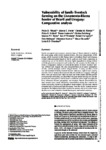Please use this identifier to cite or link to this item:
http://www.alice.cnptia.embrapa.br/alice/handle/doc/1042076| Title: | Vulnerability of family livestock farming on the Livramento-Rivera border of Brazil and Uruguay: comparative analysis. |
| Authors: | WAQUIL, P. D.  NESKE, M. Z.   RIBEIRO, C. M.   SCHLICK, F. E.   ANDREATTA, T.   PERLEBERG, C.   BORBA, M. F. S.   TRINDADE, J. P. P.   CARRIQUIRY, R.   MALAQUIN, I.   SARAIVA, A.   GONZALES, M.   CLAUDINO, L. S. D.   |
| Affiliation: | Paulo D. Waquil, UFRGS; Marcio Z. Neske, UFRGS; Claudio M. Ribeiro, EMATER-RS ASCAR; Fabio E. Schlick, EMATER-RS ASCAR; Tanice Andreatta, UNIPAMPA; Cleiton Perleberg, UNIPAMPA; MARCOS FLAVIO SILVA BORBA, CPPSUL; JOSE PEDRO PEREIRA TRINDADE, CPPSUL; Rafael Carriquiry, UDELAR; Italo Malaquin, Instituto Plan Agropecuário; Alejandro Saravia, Instituto Plan Agropecuário; Mario Gonzales, EMATER-RS ASCAR; Livio S. D. Claudino, UFPA. |
| Date Issued: | 2016 |
| Citation: | Revue d'Élevage et de Médecine Vétérinaire des Pays Tropicaux, v. 68, n. 2-3, p. 55-59, 2015. |
| Description: | Social, ecological, and economic sciences have all shown interest in studying the social group called family livestock farmers. The main characteristic of this group, which is present in the Pampa biome in Southern Brazil and Uruguay, is beef cattle production based on family work on small lands, expressing an autonomous way of life which is, however, highly dependent on strong relations with the physical environment and marked by risk aversion. |
| Thesagro: | Bovino Agricultura familiar Risco |
| ISSN: | 1951-6711 |
| Type of Material: | Artigo de periódico |
| Access: | openAccess |
| Appears in Collections: | Artigo em periódico indexado (CPPSUL)  |
Files in This Item:
| File | Description | Size | Format | |
|---|---|---|---|---|
| REMVT15055059.pdf | 669,81 kB | Adobe PDF |  View/Open |









